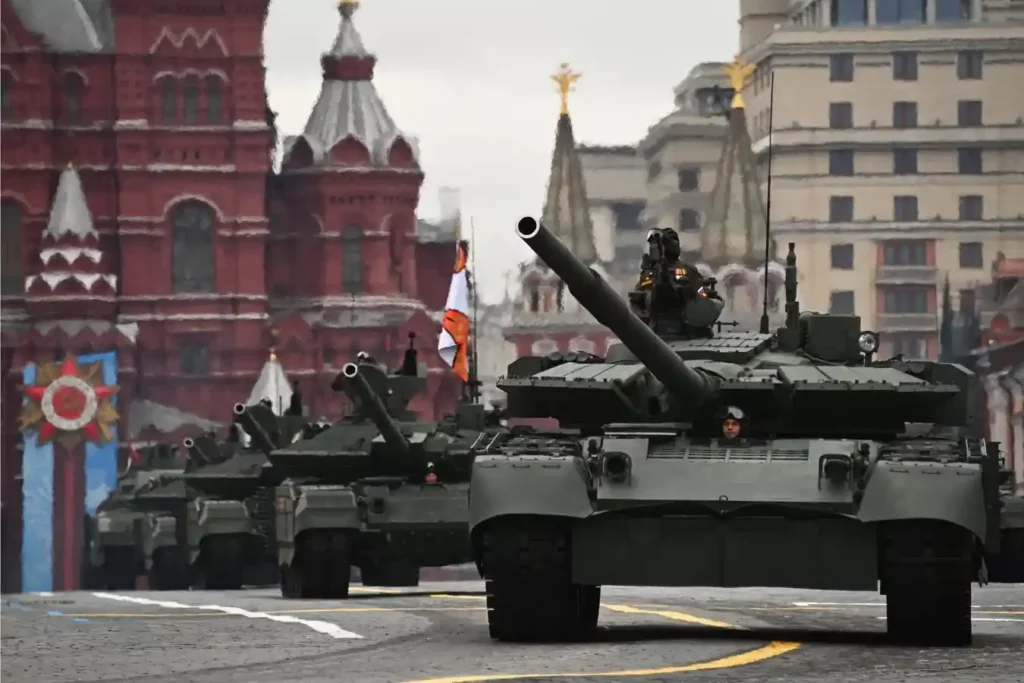
© Sputnik / Yevganiy Odinokov.
Tank warfare has evolved.
The large force-on-force armored battles that were the hallmark of much of WWII, the Arab-Israeli conflicts, which served as the foundation of operational doctrine for both NATO and the Soviet Union (and which was implemented in full by the United States during Operation Desert Storm in 1991), has run its course.
Like most military technological innovations, the ability to make a modern main battle tank survivable has been outstripped by the fielding of defensive systems designed to overcome such defenses. If a modern military force attempted to launch a large-scale tank-dominated attack against a well-equipped peer-level opponent armed with modern anti-tank missiles, the result would be a decisive defeat for the attacking party marked by the smoking hulks of burned-out tanks.
Don’t get me wrong: tanks still have a vital role to play on the modern battlefield. Their status as a mobile bunker is invaluable in the kind of meat-grinder conflicts of attrition that have come to define the current stage of large-scale ground combat. Speed and armor still contribute to survivability, and the main gun of a tank remains one of the deadliest weapons on the modern battlefield.
But the modern tank performs best as part of a combined arms team, supported by infantry (mounted and unmounted) and copious amounts of supporting arms (artillery and close air support.) As part of such a team, especially one that is well-trained in the art of close combat, the tank remains an essential weapon of war. However, if operated in isolation, a tank is simply an expensive mobile coffin.
Much has been made about the recent decision made by NATO and allied nations to provide Western main battle tanks to Ukraine. The politics of this decision is its own separate topic. This article will address the operational practicalities of this decision, namely has the military capability of Ukraine been enhanced through the provision of these new weapons systems.
To answer this question, one needs to examine three basic issues: training, logistical sustainability, and operational employment.
Training
It takes 22 weeks to train a basic American M1 Abrams crewmember. That training just gives the soldier the very basic skill set to be functional. Actual operational expertise is only achieved through months, if not years, of additional training in not just the system itself, but employing it as part of a similarly trained combine arms team. Simply put, even a Ukrainian tank crew experienced in the operation of Soviet-era T-72 or T-64 tanks will not be able to immediately transition to a Western-style main battle tank.
First and foremost, the crew size of a Soviet-era tank is three, reflecting the reality that the Soviet tanks make use of an automatic loading mechanism. Western tanks have four crew members because the loading of the main tank gun is done manually. Adapting to these dynamics takes time, and requires extensive training.
Training is expensive. NATO is currently providing Ukraine with three types of Western main battle tank: the British Challenger 2, the German Leopard 2, and the American M1A2. There is no unified training course—each tank requires its own unique training prospectus that is not directly transferable to another system.
The decentralized training processes created by such a diverse approach promotes inefficiencies and generates discrepancies in outcome—one crew will not be like another, which in combat, where units are supposed to be interchangeable to promote predictable outcomes if all other circumstances remain the same, is usually fatal.
Moreover, these problems will only be enhanced by the emphasis that will be placed on rapid outcomes. The reality is whatever training programs that are developed and delivered by the nations providing the tanks will be insufficient to the task, resulting in poorly trained crews taking extremely complicated weapons systems into the most dangerous environment in the world for a tank—the teeth of a Russian Army designed and equipped to kill these very same tanks.
Logistical Sustainability
Tanks are among the most technically challenging weapons systems on a modern battlefield. They are constantly breaking down, especially if not properly maintained. For the M1 Abrams, for every hour a tank is in the field, there are three hours of maintenance time required. This problem only becomes magnified in combat.
Normally an armor unit is equipped with highly specialized organic maintenance crews that can repair most of the minor issues that can sideline a tank. Given the training requirements to produce this level of high-quality mechanic, it is unlikely Ukraine will be provided with this kind of maintenance support.
This means that the tanks that are being provided to Ukraine will need to be returned to NATO nations for any significant repairs of equipment that is damaged through simple usage or actual combat. In short, it is highly likely that a Western main battle tank in Ukrainian hands will break down at some point during its operational use by Ukraine, meaning that the total number of tanks available to Ukraine will be far less than the number of tanks provided.
Operational Employment
Ukraine’s commander in chief of the Armed Forces, General Valerii Zaluzhnyi, told The Economist last month that he needed 300 tanks, 500 infantry fighting vehicles, and 500 artillery pieces, if he were going to have any chance of defeating Russia.
Following the January 20 meeting of the Ramstein Contact Group, and subsequent follow-on discussions about the provision of tanks, NATO and its allied partners have agreed to provide less than 50% of the number of tanks requested, less than 50% of the number of infantry fighting vehicles requested, and less than 20% of the artillery requested.
Moreover, the timetable for delivery of this equipment is staggered incoherently over a period that stretches out for many months, and in some cases extends into the next year. Not only does this complicate training and logistical sustainability issues that are already unfavorably inclined for Ukraine, but it makes any meaningful effort to integrate this material into a cohesive operational employment plan all but impossible.
In short, Ukraine will be compelled to commit the equipment provided—especially the tanks—into combat in piecemeal fashion.
The truth about tanks is that NATO and its allied nations are making Ukraine weaker, not stronger, by providing them with military systems that are overly complicated to operate, extraordinarily difficult to maintain, and impossible to survive unless employed in a cogent manner while supported by extensive combined arms partners.
The decision to provide Ukraine with Western main battle tanks is, literally, a suicide pact, something those who claim they are looking out for the best interests of Ukraine should consider before it is too late.

The best interest of Ukraine would have been in the first place to stay neutral.
Secondly to respect the signed treaty.
And last when hostilities are declared, to talk with russian diplomats, if not mr. putine about peace.
But when you let the usa rule your country to enrich a few, then pray the war ends soon, as there will be no ukraine or ukrainians left, despite all the western ” help” to continue the agony
mmm hmm Mme. Anonymous.
Alas we fear it will drag on.
What is an outcome though is that the Bio labs and skullduggery is being unearthed and the dirty Nazi scoudrels have met their match! Soros included. Enlighten me if I am wrong.
The US is not the care taker of the world it never has been nor is it ever going to be. We all thought Kissinger was a saviour but no turns out he’s not.
yes mme anonymous agrees with you. All too glad the bl** dy labs were dismanteld and nazis were exposed. Still many consider it as a ” fake news”( convenient to escape the problem) And many in europe are totally ignorant and kept in ignorance or manipulated into believing putin is an ogre and zelensky an engel. Seriously. That is what european msm serve go the public. The UK beeing the worst
As for the us, sure it is not the care taker of the world, but pretends to ” protect democraties” around the world. That is a lie to enable them to steal other countries assets.
They should start protecting their own democratie wich is dying
Nice “write up.” Could’ve been written in a few lines though: The US virtue signals help to Ukraine. Russia will destroy the tanks and soldiers, but it’s the thought that counts. THE END
yea, most of ukraine is know owned by the usa. Blackrock, monsanto and the like.
“Hero” zelensky and associates put their ” rewards” away in fiscal ” paradises”
Ukraine, after weapons deliveries owe a huge debt to the USA a.o.
Only mr. Putine thinks differently. He might be the ” saviour” of the ukrainian population after all. That is a thought shared with many. We shall see